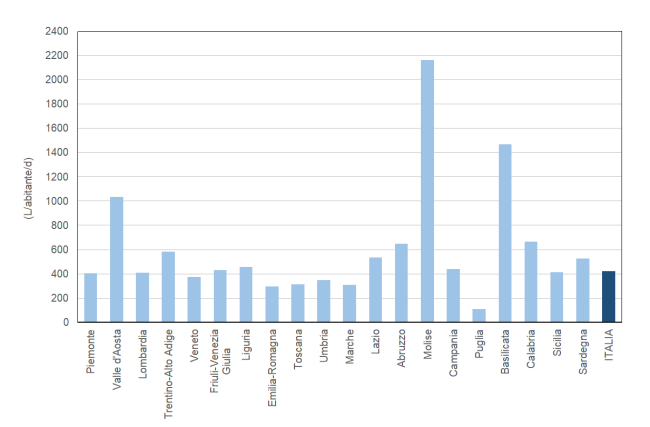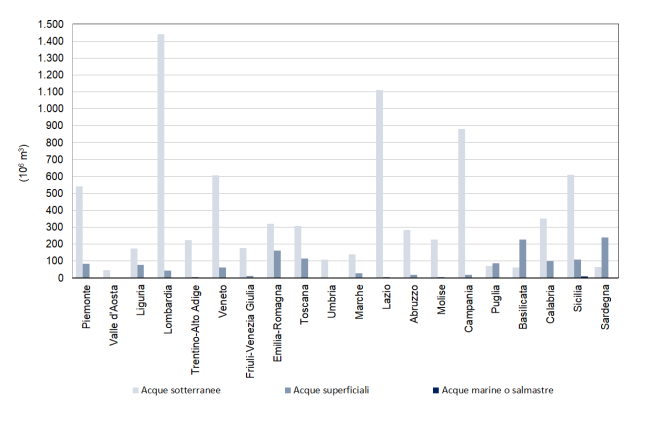Panel 1
Giovanni Braca
The indicator refers to 2022 and is drawn up on the basis of Istat data relating to the last “Nable Review for Civil Use” carried out in 2023 and published in 2024. The information is provided on a national, regional and by hydrographic district, divided in turn into removal from the surface and underground body water. The levy values are compared with those detected in the previous "Nail census for civil use" of 2020. Also in 2022, compared to the previous 2020 census, the water withdrawal for civil use in Italy has decreased slightly.
The indicator provides a measure of the pressure on surface and underground water bodies exerted by the collection of the water resource for civil use. The withdrawal of the water resource should not be confused with the amount used or delivered since it is inclusive of the dispersions or losses that occur in the adduction and distribution works much more accentuated in the civil sector. The “civilian” Istat category is identified with the “potable” category of the legislation for the request for a concession of derivation (RD 1775/33). The Census of the waters for civil use collects information from the bodies operators of water services for civil use on the entire water cycle; it is also included in the National Statistical Programme (IST – 02192), which includes all the statistical surveys of interest for the entire national community.
Analyze the quantities taken from surface and underground water bodies to get a picture of the exploitation of water resources; analyze the percentages of regional withdrawals on the national total to highlight which regions take more amounts of water resources; analyze the rate of water from surface water bodies and that from underground water bodies, in order to verify which source is most exploited and in which region.
The levy must be of such an extent that the principle of “non-deterioration” is respected for the body of water concerned or the achievement of the environmental objectives set out in Directive 2000/60/EC is guaranteed: “good ecological and chemical status” for surface water bodies and “good chemical status” for underground water bodies.
Panel 2
Istat 2014 - ANNO 2012 REPORT CENSIMENTO DELLE ACQUE PER USO CIVILE https://www.istat.it/it/files//2014/06/2014_06_26_Report_censimento_acqua.pdf
Istat 2017 - FOCUS GIORNATA MONDIALE DELL’ACQUA 2017 https://www.istat.it/it/files//2017/03/Focus_acque.pdf
Istat 2017 - ANNO 2015 REPORT CENSIMENTO DELLE ACQUE PER USO CIVILE https://www.istat.it/it/files//2017/12/Report-Censimento-acque.pdf
Istat 2018 - FOCUS GIORNATA MONDIALE DELL’ACQUA 2018 https://www.istat.it/it/files//2018/03/Focus-acque-2018.pdf
Istat 2020 - LE STATISTICHE DELL’ISTAT SULL’ACQUA | ANNI 2018-2019 https://www.istat.it/it/files//2020/03/Le-statistiche-Istat-sull%E2%80%99acqua.pdf
Istat 2024 - LE STATISTICHE DELL’ISTAT SULL’ACQUA | ANNI 2020-2023, https://www.istat.it/it/files/2024/03/Report-GMA-Anno-2024.pdf
The quantification of the volumes taken from the environment carried out by the managing bodies can also be carried out by estimates, because it is not always possible to have direct measurements.
Data quality assessment
ISTAT
National, Regional
2012, 2015, 2018, 2020, 2022
Indicator assessment
Sum of regional withdrawals. Comparison of annual data by type of source of withdrawal. Relationship with respect to the population.
Although the state is not definable, the reduction of the levy has a beneficial effect on the environment by reducing pressure on water bodies.
Compared to the previous survey of 2020, the withdrawal for total civil use in Italy in 2022 decreased by 0.5% (Figure 3).



The national value of the daily withdrawal of water for average annual civil use per inhabitant is about 424 L/inhabitant/day, with the maximum value reached in Molise with 2,160 L/abitant/day and the minimum value in Puglia with only 110 L/inhabitant/day (Figure 1). The supply is also for 2022 mainly from groundwater (84.7%) and in some regions such as the Valle d’Aosta and Umbria the water supply of water for civil use derives entirely from them (Figure 2). A very small percentage is also derived from the desalination of seawater (0.1%), in the regions of Sicily and Tuscany alone. In 2022 the water levy for civil use in Italy was reduced by 0.5% compared to the previous census, and is equal to about 9.14 billion cubic meters (Figure 3). The values of the daily per capita levy, it is good to specify, do not take into account water transfers between regions, so not all water taken in a region is delivered and used in the same region.